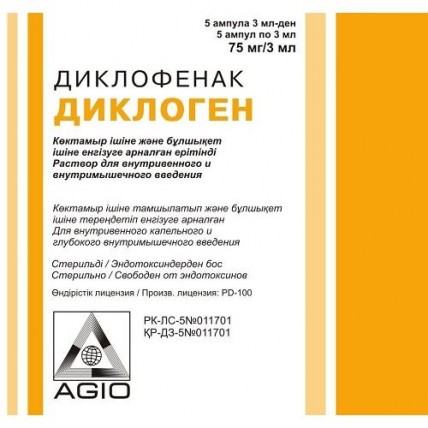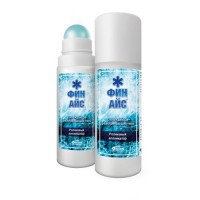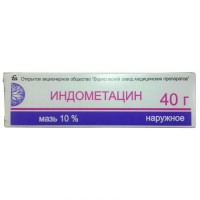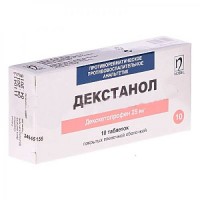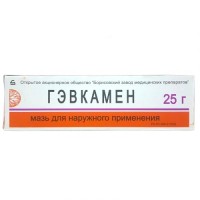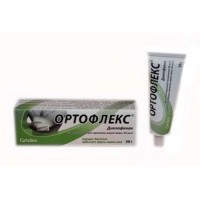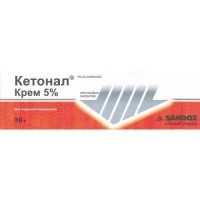Diklogen 75 mg / 3 ml 5's solution for injection in ampoules
- $2.80
The instruction for medical use
of DIKLOGEN medicine
the Trade name
Diklogen
Mezhdunarodnoye the unlicensed
name Diclofenac Dosage Form Solution for intravenous and intramuscular administration of 75 mg / 3 ml
Structure
of 3 ml of solution contain
active agent - sodium diclofenac - 75 mg,
excipients: Mannitolum, sodium sulfite anhydrous, benzyl alcohol, propylene glycol, acid chlorohydrogen, water for injections.
The description
Transparent solution from colourless till yellowish color.
Pharmacotherapeutic group
Anti-inflammatory and antirheumatic drugs. Non-steroidal anti-inflammatory drugs. Acetic acid derivatives. Diclofenac
the ATX M01AB05 Code
the Pharmacological
Pharmacokinetics Later properties of intravenous drop administration of 75 mg the maximum concentration - 1.9 mkg/ml (5.9mkmol/l). After intramuscular introduction the maximum concentration - 2.5 mkg/ml (8 µmol/l). Time of achievement of the maximum concentration - 20 min. Concentration in plasma is in linear dependence on size of the entered dose. Change of pharmacokinetics of diclofenac against the background of repeated introduction is not noted.
Communication with proteins of plasma - 95-98% (the most part contacts albumine). Gets into synovial fluid. The maximum concentration in synovial fluid is observed at 2-4 o'clock later, than in plasma. Elimination half-life from synovial fluid in 4-6 hours after administration of drug is higher, than in plasma, and remains higher within 12 hours.
50% of active agent are exposed to metabolism during the first passing through a liver. The area under a curve of concentration is twice less after oral administration of drug, than after parenteral administration of the same dose. Metabolism results from repeated or single hydroxylation and a konjyugirovaniye with glucuronic acid. Pharmacological activity of metabolites - below, than diclofenac.
The system clearance is 260 ml/min. Plasma elimination half-life - 1-2 hours. 60% of the entered dose are removed in the form of metabolites through kidneys. Less than 1% are removed in not changed look, the rest of a dose is removed in the form of metabolites with bile.
At patients with the profound renal failures (clearance of creatinine less than 10 ml/min.) removal of metabolites with bile increases, at the same time increase in their concentration in blood is not observed.
At patients with chronic hepatitis or cirrhosis pharmacokinetic parameters of diclofenac same, as well as at patients without liver diseases.
The pharmacodynamics
Has anti-inflammatory, analgetic, febrifugal effect. Oppressing a tsikloksigenaza of I and II, breaks metabolism of arachidonic acid, reduces amount of prostaglandins both in the inflammation center, and in healthy fabrics, suppresses exudative and proliferative phases of inflammation.
Reduces permeability of capillaries. Stabilizes lizosomalny membranes. Slows down production of ATP in the course of oxidizing phosphorylation, slows down synthesis of mediators of inflammation (prostaglandins). Analgetic action is caused by decrease in concentration of the biogenous amines having painful (algogenny) properties and increase in a threshold of painful sensitivity of the receptor device. Causes easing or disappearance of a pain syndrome of rheumatic and not rheumatic character.
Indications
Intramuscular introduction
- inflammatory diseases of the musculoskeletal system
(pseudorheumatism, the psoriasis, juvenile arthritis
ankylosing a spondylitis, gout)
- degenerative diseases of the musculoskeletal system (osteoarthrosis, osteochondrosis)
- a lumbago, a sciatica, neuralgia, myalgias
- inflammatory diseases of circumarticular fabrics (tendovaginitis, a bursitis, rheumatic defeat of soft tissues)
- the posttraumatic pain syndrome which is followed by inflammation, postoperative pains
- heavy attacks of migraine
- renal and hepatic gripes
Intravenous infusion
- treatment or prevention of postoperative pain in the conditions of a hospital
the Route of administration and doses
Intravenous infusion
Intravenously by drop infusion. It is appointed only in stationary conditions. The maximum daily dose - 150 mg. Just before intravenous administration of Diklogen the contents of 1 ampoule should be parted in 100-500 ml 0.9% of solution of sodium of chloride or 5% of solution of glucose (previously having added to infusion solutions bicarbonate sodium solution - 0.5 ml of 8.4% or 1 ml of 4.2% of solution). Depending on the degree of manifestation of a pain syndrome the infusion is performed within 30-180 min. Injection solution is entered intravenously within no more than 2 days.
For treatment of moderate and heavy postoperative pain of 75 mg it is necessary to enter continuously of 30 minutes till 2 o'clock. If necessary, treatment can be repeated in several hours, but the dose should not exceed 150 mg during any period at 24 o'clock.
For prevention of postoperative pain in 15 min.-1 hour after surgical intervention it is necessary to enter a load dose of 25-50 mg, after that it is necessary to perform continuous infusion about 5 mg/hour to the maximum daily dose of 150 mg.
Perhaps intramuscular introduction 1-2 times, further treatment continue intramuscular introduction For treatment of acute conditions or stopping of a pain syndrome at exacerbations of chronic diseases by oral appointment of Diklogen taking into account the maximum daily dose - 150 mg (including in day of an injection). Injection solution is entered deeply intramusculary within no more than 2 days. Duration of use of drug is defined by the attending physician.
Side effects
Very often (≥1/10)
- nausea, vomiting and diarrhea and also insignificant gastrointestinal bleedings, and in rare instances with development of anemia
it is frequent (≥ 1/100-& lt, 1/10)
- pseudo anaphylactic reactions
- reactions of hypersensitivity, such as skin rash and itching
- disturbances from the central nervous system, such as headache, dizziness, oglushennost, excitement, irritability or fatigue
- the dispeptitchesky phenomena, a meteorism, gripes in a stomach, lack of appetite and also gastrointestinal ulcers (with risk of bleeding and perforation)
- increase in activity of transaminases in blood serum
- reactions in the place of an injection, pain in the place of an injection, an induration in the place of an injection
- a liquid delay
Sometimes (≥ 1/1000-& lt, 1/100)
- urticaria
- a hematemesis, a melena or a bloody diarrhea
- an abnormal liver function, especially at long therapy, an acute hepatitis with jaundice or without it (lightning hepatitis even without the previous symptoms is in rare instances possible).
Therefore at long-term treatment it is regularly necessary to carry out by drug the analysis of hepatic indicators.
- an alopecia
- developing of hypostases, especially at patients with arterial hypertension or a renal failure
Seldom (≥ 1/10000-& lt, 1/1000)
- hypostasis, necrosis in the place of an injection
- reactions of hypersensitivity to benzyl alcohol meet
seldom Very seldom (& lt, 1/10000) including isolated cases
- abscess in the place of an injection
- hemopoiesis disturbances (anemia, a leukopenia, thrombocytopenia, a pancytopenia, an agranulocytosis), hemolytic anemia
- heavy generalized reactions of hypersensitivity: a Quincke's edema (a face edema, a paraglossa, hypostasis internal throats with narrowing of airways, short wind, increase of heart rate, a lowering of arterial pressure, falling of arterial blood pressure to critical level).
- an allergic vasculitis and a pneumonitis
- psychotic reactions, a depression, feeling of alarm, dreadful dreams
- touch disorders, disturbances of flavoring perception, memory, a disorientation, spasms, a tremor
- mental disorders, such as memory disturbance
- a disorder of vision (blurring of sight or a diplopia)
- sonitus, passing disorders of hearing
- heartbeat, hypostases, heart failure, a myocardial infarction
- an arterial hypertension
- an acute disorder of cerebral circulation
- stomatitis, a glossitis, damages of a gullet, the complaint to pain in the lower part of a stomach (for example, bleeding in colitis or aggravation of nonspecific ulcer colitis / Crohn's disease), a constipation, pancreatitis, diafragmopodobny strictures of intestines.
- a dieback, eczema, a multiformny erythema, a photosensitization, a purpura (including an allergic purpura), such bullous reactions as Stephens's syndrome — Johnson and a toxic epidermal necrolysis
- defeat of tissue of kidneys (interstitial nephrite, papillary necrosis) which can be followed by an acute renal failure, a proteinuria and/or a hamaturia, a nephrotic syndrome
- aggravation of inflammatory processes of infectious origin (for example, development of a necrotizing fasciitis), connected with system use of non-steroidal anti-inflammatory drugs. Perhaps, it is connected with the mechanism of action of NPVP.
- symptoms of aseptic meningitis, such as muscle tension of a nape, headache, nausea, vomiting, temperature increase or turbidity of consciousness. Patients with autoimmune diseases are predisposed to emergence of such states (a system lupus erythematosus, mixed collagenoses).
Contraindications
should not be applied in the following cases:
- hypersensitivity to active ingredient or one of other components of drug
- in the presence in the anamnesis of a bronchospasm, asthma, rhinitis or urticaria after intake of acetylsalicylic acid or other non-steroidal anti-inflammatory drugs
- at disturbances of a hemopoiesis of the obscure origin, disturbance of a hemostasis and fibrillation
- treatment of postoperative pain after operation of coronary shunting (or uses of the cardiopulmonary bypass)
- inflammatory bowel diseases (Crohn's disease or ulcer colitis)
- in the presence in the present or in the past of a recurrent round ulcer / hemorrhages (two or more separate cases of the confirmed peptic ulcer or bleedings)
- in the presence in the anamnesis of gastrointestinal bleeding or perforation of an ulcer connected with intake of non-steroidal anti-inflammatory drugs
- fresh cerebrovascular or other bleedings
- the established stagnant heart failure (class II-IV NYHA), coronary heart disease, diseases of peripheral arteries or vessels of a brain
- an abnormal liver function or kidneys of heavy degree
- heart failure of heavy degree
- pregnancy and the period of a lactation
- children's and teenage age up to 18 years
Medicinal interactions
Other NPVP, including salicylates:
The accompanying use of some NPVP can increase risk of developing of ulcers and gastrointestinal bleeding owing to synergy effect of drugs. In this regard combined use of diclofenac and other NPVP is not recommended.
Digoxin, Phenytoinum, lithium:
At joint administration of diclofenac can increase concentration of digoxin, Phenytoinum and lithium in blood. In this regard at treatment by diclofenac control of serumal concentration of lithium is obligatory, and digoxin or Phenytoinum - is recommended.
Diuretics, APF inhibitors and antagonists of angiotensin II: NPVP can reduce efficiency of diuretics and other antihypertensive drugs (such as beta-blockers, inhibitors of the angiotensin-converting enzyme (ACE)). At some patients with reduced renal function (e.g., in dehydration or at elderly patients with the lowered function of kidneys) at intake of APF inhibitors or antagonists of angiotensin II together with the drug inhibiting cyclooxygenase, perhaps further deterioration in renal function including possible development of an acute renal failure which, however, in most cases has reversible character. In this regard it is necessary to appoint the specified drugs with care in combination with diclofenac, especially at elderly patients. At joint administration of diclofenac and these drugs it is necessary to watch that the patient accepted adequate amount of liquid and also it is necessary - after an initiation of treatment - to control function of kidneys regularly. The accompanying use of diclofenac and kaliysberegayushchy diuretics can lead to development of a hyperpotassemia. In this regard it is recommended to control potassium concentration in blood at joint administration of the specified drugs.
Glucocorticoids:
At joint introduction with diclofenac the risk of developing ulcers and gastrointestinal bleeding increases.
The drugs suppressing aggregation of thrombocytes (for example, acetylsalicylic acid), and selective serotonin reuptake inhibitors (SSRI):
At joint introduction with diclofenac the risk of gastrointestinal bleeding increases.
Antidiabetic drugs:
Clinical trials showed that diclofenac can be applied together with peroralnymp antidiabetic drugs, without influencing their action. Nevertheless, there are separate messages about the hypoglycemic and hyper glycemic phenomena which demanded dose adjustment of antidiabetic drugs during treatment by diclofenac. For this reason, as a precautionary measure, at simultaneous use of these drugs it is recommended to carry out regular control of level of glucose to blood.
Methotrexate:
Diclofenac is capable to suppress renal clearance of a methotrexate that leads to increase in its level. At administration of diclofenac during 24 h to or after introduction of a methotrexate the increase in concentration of a methotrexate in blood and strengthening of its toxic effects is possible. Cyclosporine:
NPVP (e.g., sodium diclofenac) can strengthen nephrotoxic effect of cyclosporine.
Antibiotics of a hinolonovy row:
It was reported about isolated cases of appearance of spasms which could be caused by simultaneous use of hinolon with NPVS.
Anticoagulants:
NPVP can strengthen effect of anticoagulants, such as warfarin Sulphonylurea:
There are separate messages about the changes of concentration of glucose in blood after use of diclofenac which demanded dose adjustment of antidiabetic drug. In this regard at joint therapy it is recommended to control concentration of glucose in blood. Probenetsid and Sulfinpyrazonum:
The medicines containing probenetsid and Sulfinpyrazonum, can delay removal of diclofenac from an organism.
Kolestipol and holestiramin:
These drugs are capable to cause decrease or delay of absorption of diclofenac. For this reason it is recommended to appoint diclofenac, at least, for an hour before reception kolestipola/a holestiramina or 4-6 hours later after it.
Strong CYP2C9 inhibitors:
It is necessary to appoint with care diclofenac along with strong CYP2C9 inhibitors (as, for example Sulfinpyrazonum and vorikonazol) as at their concomitant use the increase in peak concentration of diclofenac in plasma and strengthening of its action in connection with delay of his metabolism is possible.
Special instructions
the General
It is necessary to avoid use of the drug Diklogen with system NPVP, including selection inhibitors of cyclooxygenase-2, in view of lack of any synergy advantage and a possibility of development of additional side effects.
It is necessary to be careful when prescribing drug to elderly people. With poor health and for patients with a low indicator of body weight it is recommended to apply the lowest effective doses to people of advanced age.
Asthma in the anamnesis
At patients with bronchial asthma, seasonal allergic rhinitis, a rhinedema (nasal polyps), with the chronic obstructive diseases of lungs or persistent infections of airways (which are especially connected with allergic, similar to rhinitises, symptoms) more often than others have reactions to NPVP similar to exacerbation of asthma, a Quincke's edema or urticaria. Special measures (readiness for rendering emergency aid) are recommended to such patients. It also concerns patients with an allergy to other substances, for example, with skin reactions, an itching or urticaria.
Special cautions are recommended in case Diklogen is applied parenterally to patients with bronchial asthma as symptoms can become aggravated.
Influence on digestive system
As well as at use of other NPVP, when prescribing the drug Diklogen to patients with the symptoms demonstrating disturbances from the digestive system (DS) with presence of stomach ulcer or intestines, bleeding or perforation in the anamnesis, is obligatory medical observation and extra care. The risk of developing of bleeding in digestive tract increases with increase in a dose of drug at patients with an ulcer in the anamnesis, especially with complications in the form of bleeding or perforation, and at people of advanced age.
To reduce risk of toxic impact on PS at patients with an ulcer in the anamnesis, especially with complications in the form of bleeding or perforation and at people of advanced age, treatment is begun and supported by low effective doses.
For such patients and also the patients needing the accompanying use of the medicines containing low doses of acetylsalicylic acid or other medicines which presumably increase risk of undesirable impact on PS it is necessary to consider a question of use of combination therapy using protective equipment (for example, inhibitors of the proton pump or a mizoprostol).
Patients with gastrointestinal toxicity in the anamnesis, especially advanced age, have to report about any unusual abdominal symptoms (especially bleedings in PS). Cautions are also necessary for the patients receiving the accompanying drugs which can increase risk of developing an ulcer or bleeding, such as system corticosteroids, anticoagulants, antitrombotichesky means or selective serotonin reuptake inhibitors.
Influence on a liver
Careful medical control is necessary in case Diklogen is appointed to patients with an abnormal liver function as the condition of such patients can become aggravated.
As well as at use of other NPVP, the level of one and more hepatic enzymes can increase. During long-term treatment, regular control of function of a liver is appointed the drug Diklogen (tablets or suppositories). If abnormal liver functions remain or worsen and also if the symptoms connected with the progressing liver diseases or other manifestations are observed (for example, an eosinophilia, rash), use of the drug Diklogen should be stopped. The course of diseases, such as hepatitis, can pass without prodromal symptoms.
The care is necessary in case Diklogen is applied at patients with a hepatic porphyria because of the probability of provocation of an attack.
Influence on kidneys
As at treatment of NPVP was reported about a delay of liquid and hypostasis, monitoring of renal function by the patient with dysfunction of heart or kidneys (including with a functional renal failure against the background of a hypovolemia, a nephrotic syndrome, a lupoid nephropathy and dekompensirovanny cirrhosis), arterial hypertension in the anamnesis is recommended, to the patients of advanced age, patients receiving therapy by diuretics or drugs which significantly influence function of kidneys, and to patients with significant decrease in extracellular volume of liquid for any reason, for example, to or after serious surgical intervention. The termination of therapy of NPVP usually leads to return to a state which preceded treatment.
Influence on hematologic indicators
At prolonged use of drug, as well as other NPVP, is recommended blood test monitoring. As well as other NPVP, Diklogen can temporarily inhibit aggregation of thrombocytes. It is necessary to watch carefully patients with disturbances of a hemostasis.
Influence on the cardiovascular
Treatment of NPVP system, including diclofenac, especially in high doses and during the long period, can be connected with small increase in risk of serious cardiovascular cases of thrombosis (including a myocardial infarction and a stroke). At the patients accepting NPVP, especially at patients with cardiovascular risk factors it is necessary to apply a minimal effective dose to minimizing of potential risk of collateral cardiovascular complications at the smallest admissible duration of treatment.
The feature of influence of medicine on ability to run the vehicle or potentially dangerous mechanisms
needs to abstain from occupations potentially dangerous types of activity demanding the increased concentration of attention and speed of psychomotor reactions.
Overdose
Symptoms: dizziness, a headache, a hyperventilation of lungs, consciousness turbidity, children have myoclonic spasms, nausea, vomiting, abdominal pain, bleedings, an abnormal liver function and kidneys.
Treatment: gastric lavage, administration of activated carbon, the symptomatic therapy directed to elimination of increase in arterial blood pressure, a renal failure, spasms, irritations of digestive tract, respiratory depression. The artificial diuresis, a hemodialysis are ineffective. There is no specific antidote.
The form of release and packing
On 3 ml of drug place in an ampoule of transparent glass, on 5 ampoules place in a plastic tray or in blister strip packaging from a foil of an aluminum and transparent film from PVC.
The plastic tray or blister strip packaging together with the instruction for medical use in the state and Russian languages are placed in a cardboard box.
To Store storage conditions in the dry, protected from light place at a temperature not higher than 25 wasps.
Not to freeze!
To store out of children's reach!
A period of storage
3 years
not to use after an expiration date
Prescription status
According to the prescription
of Proizvoditel Adzhio Pharmatsevtikalz Ltd
A — 38, Nandizhiot Indastrial Estayt, Safedpool, Kurla-Andheri Road, Mumbai -
400 072 Ph. +91-22-28518206/42319000
Fax: +91-22-28518204
regulatory@agio-pharma.com
the Owner of the registration certificate
of Adzhio Pharmatsevtikalz Ltd
the Address of the organization accepting in the territory of the Republic of Kazakhstan claims from consumers on quality of products:
Almaty, Shevchenko St., 118, office 228
ph. +7 (727) 2240402
regulatory@agio-pharma.com
to Develop representative office of Adzhio Pharmatsevtikalz Limited
of DIKLOGEN medicine
the Trade name
Diklogen
Mezhdunarodnoye the unlicensed
name Diclofenac Dosage Form Solution for intravenous and intramuscular administration of 75 mg / 3 ml
Structure
of 3 ml of solution contain
active agent - sodium diclofenac - 75 mg,
excipients: Mannitolum, sodium sulfite anhydrous, benzyl alcohol, propylene glycol, acid chlorohydrogen, water for injections.
The description
Transparent solution from colourless till yellowish color.
Pharmacotherapeutic group
Anti-inflammatory and antirheumatic drugs. Non-steroidal anti-inflammatory drugs. Acetic acid derivatives. Diclofenac
the ATX M01AB05 Code
the Pharmacological
Pharmacokinetics Later properties of intravenous drop administration of 75 mg the maximum concentration - 1.9 mkg/ml (5.9mkmol/l). After intramuscular introduction the maximum concentration - 2.5 mkg/ml (8 µmol/l). Time of achievement of the maximum concentration - 20 min. Concentration in plasma is in linear dependence on size of the entered dose. Change of pharmacokinetics of diclofenac against the background of repeated introduction is not noted.
Communication with proteins of plasma - 95-98% (the most part contacts albumine). Gets into synovial fluid. The maximum concentration in synovial fluid is observed at 2-4 o'clock later, than in plasma. Elimination half-life from synovial fluid in 4-6 hours after administration of drug is higher, than in plasma, and remains higher within 12 hours.
50% of active agent are exposed to metabolism during the first passing through a liver. The area under a curve of concentration is twice less after oral administration of drug, than after parenteral administration of the same dose. Metabolism results from repeated or single hydroxylation and a konjyugirovaniye with glucuronic acid. Pharmacological activity of metabolites - below, than diclofenac.
The system clearance is 260 ml/min. Plasma elimination half-life - 1-2 hours. 60% of the entered dose are removed in the form of metabolites through kidneys. Less than 1% are removed in not changed look, the rest of a dose is removed in the form of metabolites with bile.
At patients with the profound renal failures (clearance of creatinine less than 10 ml/min.) removal of metabolites with bile increases, at the same time increase in their concentration in blood is not observed.
At patients with chronic hepatitis or cirrhosis pharmacokinetic parameters of diclofenac same, as well as at patients without liver diseases.
The pharmacodynamics
Has anti-inflammatory, analgetic, febrifugal effect. Oppressing a tsikloksigenaza of I and II, breaks metabolism of arachidonic acid, reduces amount of prostaglandins both in the inflammation center, and in healthy fabrics, suppresses exudative and proliferative phases of inflammation.
Reduces permeability of capillaries. Stabilizes lizosomalny membranes. Slows down production of ATP in the course of oxidizing phosphorylation, slows down synthesis of mediators of inflammation (prostaglandins). Analgetic action is caused by decrease in concentration of the biogenous amines having painful (algogenny) properties and increase in a threshold of painful sensitivity of the receptor device. Causes easing or disappearance of a pain syndrome of rheumatic and not rheumatic character.
Indications
Intramuscular introduction
- inflammatory diseases of the musculoskeletal system
(pseudorheumatism, the psoriasis, juvenile arthritis
ankylosing a spondylitis, gout)
- degenerative diseases of the musculoskeletal system (osteoarthrosis, osteochondrosis)
- a lumbago, a sciatica, neuralgia, myalgias
- inflammatory diseases of circumarticular fabrics (tendovaginitis, a bursitis, rheumatic defeat of soft tissues)
- the posttraumatic pain syndrome which is followed by inflammation, postoperative pains
- heavy attacks of migraine
- renal and hepatic gripes
Intravenous infusion
- treatment or prevention of postoperative pain in the conditions of a hospital
the Route of administration and doses
Intravenous infusion
Intravenously by drop infusion. It is appointed only in stationary conditions. The maximum daily dose - 150 mg. Just before intravenous administration of Diklogen the contents of 1 ampoule should be parted in 100-500 ml 0.9% of solution of sodium of chloride or 5% of solution of glucose (previously having added to infusion solutions bicarbonate sodium solution - 0.5 ml of 8.4% or 1 ml of 4.2% of solution). Depending on the degree of manifestation of a pain syndrome the infusion is performed within 30-180 min. Injection solution is entered intravenously within no more than 2 days.
For treatment of moderate and heavy postoperative pain of 75 mg it is necessary to enter continuously of 30 minutes till 2 o'clock. If necessary, treatment can be repeated in several hours, but the dose should not exceed 150 mg during any period at 24 o'clock.
For prevention of postoperative pain in 15 min.-1 hour after surgical intervention it is necessary to enter a load dose of 25-50 mg, after that it is necessary to perform continuous infusion about 5 mg/hour to the maximum daily dose of 150 mg.
Perhaps intramuscular introduction 1-2 times, further treatment continue intramuscular introduction For treatment of acute conditions or stopping of a pain syndrome at exacerbations of chronic diseases by oral appointment of Diklogen taking into account the maximum daily dose - 150 mg (including in day of an injection). Injection solution is entered deeply intramusculary within no more than 2 days. Duration of use of drug is defined by the attending physician.
Side effects
Very often (≥1/10)
- nausea, vomiting and diarrhea and also insignificant gastrointestinal bleedings, and in rare instances with development of anemia
it is frequent (≥ 1/100-& lt, 1/10)
- pseudo anaphylactic reactions
- reactions of hypersensitivity, such as skin rash and itching
- disturbances from the central nervous system, such as headache, dizziness, oglushennost, excitement, irritability or fatigue
- the dispeptitchesky phenomena, a meteorism, gripes in a stomach, lack of appetite and also gastrointestinal ulcers (with risk of bleeding and perforation)
- increase in activity of transaminases in blood serum
- reactions in the place of an injection, pain in the place of an injection, an induration in the place of an injection
- a liquid delay
Sometimes (≥ 1/1000-& lt, 1/100)
- urticaria
- a hematemesis, a melena or a bloody diarrhea
- an abnormal liver function, especially at long therapy, an acute hepatitis with jaundice or without it (lightning hepatitis even without the previous symptoms is in rare instances possible).
Therefore at long-term treatment it is regularly necessary to carry out by drug the analysis of hepatic indicators.
- an alopecia
- developing of hypostases, especially at patients with arterial hypertension or a renal failure
Seldom (≥ 1/10000-& lt, 1/1000)
- hypostasis, necrosis in the place of an injection
- reactions of hypersensitivity to benzyl alcohol meet
seldom Very seldom (& lt, 1/10000) including isolated cases
- abscess in the place of an injection
- hemopoiesis disturbances (anemia, a leukopenia, thrombocytopenia, a pancytopenia, an agranulocytosis), hemolytic anemia
- heavy generalized reactions of hypersensitivity: a Quincke's edema (a face edema, a paraglossa, hypostasis internal throats with narrowing of airways, short wind, increase of heart rate, a lowering of arterial pressure, falling of arterial blood pressure to critical level).
- an allergic vasculitis and a pneumonitis
- psychotic reactions, a depression, feeling of alarm, dreadful dreams
- touch disorders, disturbances of flavoring perception, memory, a disorientation, spasms, a tremor
- mental disorders, such as memory disturbance
- a disorder of vision (blurring of sight or a diplopia)
- sonitus, passing disorders of hearing
- heartbeat, hypostases, heart failure, a myocardial infarction
- an arterial hypertension
- an acute disorder of cerebral circulation
- stomatitis, a glossitis, damages of a gullet, the complaint to pain in the lower part of a stomach (for example, bleeding in colitis or aggravation of nonspecific ulcer colitis / Crohn's disease), a constipation, pancreatitis, diafragmopodobny strictures of intestines.
- a dieback, eczema, a multiformny erythema, a photosensitization, a purpura (including an allergic purpura), such bullous reactions as Stephens's syndrome — Johnson and a toxic epidermal necrolysis
- defeat of tissue of kidneys (interstitial nephrite, papillary necrosis) which can be followed by an acute renal failure, a proteinuria and/or a hamaturia, a nephrotic syndrome
- aggravation of inflammatory processes of infectious origin (for example, development of a necrotizing fasciitis), connected with system use of non-steroidal anti-inflammatory drugs. Perhaps, it is connected with the mechanism of action of NPVP.
- symptoms of aseptic meningitis, such as muscle tension of a nape, headache, nausea, vomiting, temperature increase or turbidity of consciousness. Patients with autoimmune diseases are predisposed to emergence of such states (a system lupus erythematosus, mixed collagenoses).
Contraindications
should not be applied in the following cases:
- hypersensitivity to active ingredient or one of other components of drug
- in the presence in the anamnesis of a bronchospasm, asthma, rhinitis or urticaria after intake of acetylsalicylic acid or other non-steroidal anti-inflammatory drugs
- at disturbances of a hemopoiesis of the obscure origin, disturbance of a hemostasis and fibrillation
- treatment of postoperative pain after operation of coronary shunting (or uses of the cardiopulmonary bypass)
- inflammatory bowel diseases (Crohn's disease or ulcer colitis)
- in the presence in the present or in the past of a recurrent round ulcer / hemorrhages (two or more separate cases of the confirmed peptic ulcer or bleedings)
- in the presence in the anamnesis of gastrointestinal bleeding or perforation of an ulcer connected with intake of non-steroidal anti-inflammatory drugs
- fresh cerebrovascular or other bleedings
- the established stagnant heart failure (class II-IV NYHA), coronary heart disease, diseases of peripheral arteries or vessels of a brain
- an abnormal liver function or kidneys of heavy degree
- heart failure of heavy degree
- pregnancy and the period of a lactation
- children's and teenage age up to 18 years
Medicinal interactions
Other NPVP, including salicylates:
The accompanying use of some NPVP can increase risk of developing of ulcers and gastrointestinal bleeding owing to synergy effect of drugs. In this regard combined use of diclofenac and other NPVP is not recommended.
Digoxin, Phenytoinum, lithium:
At joint administration of diclofenac can increase concentration of digoxin, Phenytoinum and lithium in blood. In this regard at treatment by diclofenac control of serumal concentration of lithium is obligatory, and digoxin or Phenytoinum - is recommended.
Diuretics, APF inhibitors and antagonists of angiotensin II: NPVP can reduce efficiency of diuretics and other antihypertensive drugs (such as beta-blockers, inhibitors of the angiotensin-converting enzyme (ACE)). At some patients with reduced renal function (e.g., in dehydration or at elderly patients with the lowered function of kidneys) at intake of APF inhibitors or antagonists of angiotensin II together with the drug inhibiting cyclooxygenase, perhaps further deterioration in renal function including possible development of an acute renal failure which, however, in most cases has reversible character. In this regard it is necessary to appoint the specified drugs with care in combination with diclofenac, especially at elderly patients. At joint administration of diclofenac and these drugs it is necessary to watch that the patient accepted adequate amount of liquid and also it is necessary - after an initiation of treatment - to control function of kidneys regularly. The accompanying use of diclofenac and kaliysberegayushchy diuretics can lead to development of a hyperpotassemia. In this regard it is recommended to control potassium concentration in blood at joint administration of the specified drugs.
Glucocorticoids:
At joint introduction with diclofenac the risk of developing ulcers and gastrointestinal bleeding increases.
The drugs suppressing aggregation of thrombocytes (for example, acetylsalicylic acid), and selective serotonin reuptake inhibitors (SSRI):
At joint introduction with diclofenac the risk of gastrointestinal bleeding increases.
Antidiabetic drugs:
Clinical trials showed that diclofenac can be applied together with peroralnymp antidiabetic drugs, without influencing their action. Nevertheless, there are separate messages about the hypoglycemic and hyper glycemic phenomena which demanded dose adjustment of antidiabetic drugs during treatment by diclofenac. For this reason, as a precautionary measure, at simultaneous use of these drugs it is recommended to carry out regular control of level of glucose to blood.
Methotrexate:
Diclofenac is capable to suppress renal clearance of a methotrexate that leads to increase in its level. At administration of diclofenac during 24 h to or after introduction of a methotrexate the increase in concentration of a methotrexate in blood and strengthening of its toxic effects is possible. Cyclosporine:
NPVP (e.g., sodium diclofenac) can strengthen nephrotoxic effect of cyclosporine.
Antibiotics of a hinolonovy row:
It was reported about isolated cases of appearance of spasms which could be caused by simultaneous use of hinolon with NPVS.
Anticoagulants:
NPVP can strengthen effect of anticoagulants, such as warfarin Sulphonylurea:
There are separate messages about the changes of concentration of glucose in blood after use of diclofenac which demanded dose adjustment of antidiabetic drug. In this regard at joint therapy it is recommended to control concentration of glucose in blood. Probenetsid and Sulfinpyrazonum:
The medicines containing probenetsid and Sulfinpyrazonum, can delay removal of diclofenac from an organism.
Kolestipol and holestiramin:
These drugs are capable to cause decrease or delay of absorption of diclofenac. For this reason it is recommended to appoint diclofenac, at least, for an hour before reception kolestipola/a holestiramina or 4-6 hours later after it.
Strong CYP2C9 inhibitors:
It is necessary to appoint with care diclofenac along with strong CYP2C9 inhibitors (as, for example Sulfinpyrazonum and vorikonazol) as at their concomitant use the increase in peak concentration of diclofenac in plasma and strengthening of its action in connection with delay of his metabolism is possible.
Special instructions
the General
It is necessary to avoid use of the drug Diklogen with system NPVP, including selection inhibitors of cyclooxygenase-2, in view of lack of any synergy advantage and a possibility of development of additional side effects.
It is necessary to be careful when prescribing drug to elderly people. With poor health and for patients with a low indicator of body weight it is recommended to apply the lowest effective doses to people of advanced age.
Asthma in the anamnesis
At patients with bronchial asthma, seasonal allergic rhinitis, a rhinedema (nasal polyps), with the chronic obstructive diseases of lungs or persistent infections of airways (which are especially connected with allergic, similar to rhinitises, symptoms) more often than others have reactions to NPVP similar to exacerbation of asthma, a Quincke's edema or urticaria. Special measures (readiness for rendering emergency aid) are recommended to such patients. It also concerns patients with an allergy to other substances, for example, with skin reactions, an itching or urticaria.
Special cautions are recommended in case Diklogen is applied parenterally to patients with bronchial asthma as symptoms can become aggravated.
Influence on digestive system
As well as at use of other NPVP, when prescribing the drug Diklogen to patients with the symptoms demonstrating disturbances from the digestive system (DS) with presence of stomach ulcer or intestines, bleeding or perforation in the anamnesis, is obligatory medical observation and extra care. The risk of developing of bleeding in digestive tract increases with increase in a dose of drug at patients with an ulcer in the anamnesis, especially with complications in the form of bleeding or perforation, and at people of advanced age.
To reduce risk of toxic impact on PS at patients with an ulcer in the anamnesis, especially with complications in the form of bleeding or perforation and at people of advanced age, treatment is begun and supported by low effective doses.
For such patients and also the patients needing the accompanying use of the medicines containing low doses of acetylsalicylic acid or other medicines which presumably increase risk of undesirable impact on PS it is necessary to consider a question of use of combination therapy using protective equipment (for example, inhibitors of the proton pump or a mizoprostol).
Patients with gastrointestinal toxicity in the anamnesis, especially advanced age, have to report about any unusual abdominal symptoms (especially bleedings in PS). Cautions are also necessary for the patients receiving the accompanying drugs which can increase risk of developing an ulcer or bleeding, such as system corticosteroids, anticoagulants, antitrombotichesky means or selective serotonin reuptake inhibitors.
Influence on a liver
Careful medical control is necessary in case Diklogen is appointed to patients with an abnormal liver function as the condition of such patients can become aggravated.
As well as at use of other NPVP, the level of one and more hepatic enzymes can increase. During long-term treatment, regular control of function of a liver is appointed the drug Diklogen (tablets or suppositories). If abnormal liver functions remain or worsen and also if the symptoms connected with the progressing liver diseases or other manifestations are observed (for example, an eosinophilia, rash), use of the drug Diklogen should be stopped. The course of diseases, such as hepatitis, can pass without prodromal symptoms.
The care is necessary in case Diklogen is applied at patients with a hepatic porphyria because of the probability of provocation of an attack.
Influence on kidneys
As at treatment of NPVP was reported about a delay of liquid and hypostasis, monitoring of renal function by the patient with dysfunction of heart or kidneys (including with a functional renal failure against the background of a hypovolemia, a nephrotic syndrome, a lupoid nephropathy and dekompensirovanny cirrhosis), arterial hypertension in the anamnesis is recommended, to the patients of advanced age, patients receiving therapy by diuretics or drugs which significantly influence function of kidneys, and to patients with significant decrease in extracellular volume of liquid for any reason, for example, to or after serious surgical intervention. The termination of therapy of NPVP usually leads to return to a state which preceded treatment.
Influence on hematologic indicators
At prolonged use of drug, as well as other NPVP, is recommended blood test monitoring. As well as other NPVP, Diklogen can temporarily inhibit aggregation of thrombocytes. It is necessary to watch carefully patients with disturbances of a hemostasis.
Influence on the cardiovascular
Treatment of NPVP system, including diclofenac, especially in high doses and during the long period, can be connected with small increase in risk of serious cardiovascular cases of thrombosis (including a myocardial infarction and a stroke). At the patients accepting NPVP, especially at patients with cardiovascular risk factors it is necessary to apply a minimal effective dose to minimizing of potential risk of collateral cardiovascular complications at the smallest admissible duration of treatment.
The feature of influence of medicine on ability to run the vehicle or potentially dangerous mechanisms
needs to abstain from occupations potentially dangerous types of activity demanding the increased concentration of attention and speed of psychomotor reactions.
Overdose
Symptoms: dizziness, a headache, a hyperventilation of lungs, consciousness turbidity, children have myoclonic spasms, nausea, vomiting, abdominal pain, bleedings, an abnormal liver function and kidneys.
Treatment: gastric lavage, administration of activated carbon, the symptomatic therapy directed to elimination of increase in arterial blood pressure, a renal failure, spasms, irritations of digestive tract, respiratory depression. The artificial diuresis, a hemodialysis are ineffective. There is no specific antidote.
The form of release and packing
On 3 ml of drug place in an ampoule of transparent glass, on 5 ampoules place in a plastic tray or in blister strip packaging from a foil of an aluminum and transparent film from PVC.
The plastic tray or blister strip packaging together with the instruction for medical use in the state and Russian languages are placed in a cardboard box.
To Store storage conditions in the dry, protected from light place at a temperature not higher than 25 wasps.
Not to freeze!
To store out of children's reach!
A period of storage
3 years
not to use after an expiration date
Prescription status
According to the prescription
of Proizvoditel Adzhio Pharmatsevtikalz Ltd
A — 38, Nandizhiot Indastrial Estayt, Safedpool, Kurla-Andheri Road, Mumbai -
400 072 Ph. +91-22-28518206/42319000
Fax: +91-22-28518204
regulatory@agio-pharma.com
the Owner of the registration certificate
of Adzhio Pharmatsevtikalz Ltd
the Address of the organization accepting in the territory of the Republic of Kazakhstan claims from consumers on quality of products:
Almaty, Shevchenko St., 118, office 228
ph. +7 (727) 2240402
regulatory@agio-pharma.com
to Develop representative office of Adzhio Pharmatsevtikalz Limited
